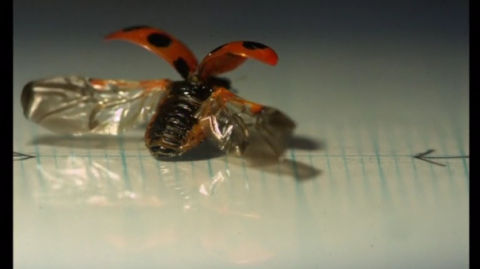
TOKYO, Japan (Reuters) — Scientists in Tokyo have replaced a ladybird beetle’s outer wing casing with an artificial see-through one, to better observe its complex folding mechanism.
Assistant Professor Kazuya Saito, the lead researcher, said he was impressed with the speed with which the ladybird beetle or the ladybird can both deploy its wings for flight and store them when landing and walking.
“The amazing thing about an insect’s wing is that it isn’t just capable of being small but it can open up in an instant and be folded back in an instant,” Saito said.
The outer, red and black layer of a ladybird’s wing is known as the elytra and is used to cover and protect its inner hindwings, which are used for flight.
The team used transparent ultraviolet-light-cured resin, the same material used in fingernail boutiques, to create a see-through elytra which was then glued into place.
Saito said he expected to discover a complex folding wing structure underneath and was surprised by its simplicity.
“If you observe the framework of a ladybird’s wings, you will first notice that the folding mechanism is very complex. I initially thought that I would discover a complex mechanism filled with joints, but what I observed was a very simple structure, and a wing frame that has no joints,” he said.
Using high-speed camera techniques and a three-dimensional computer animation of the wing’s internal structures Saito has discovered the wings have a spring-like elastic frame and uniquely-shaped veins that play an important role in its operation.
Saito says he hopes to apply the same folding mechanism to make large-scale tasks like launching solar panels and satellite antennas into space, more compact.
The research was published in Proceedings of the National Academy of Sciences of the United States of America.







